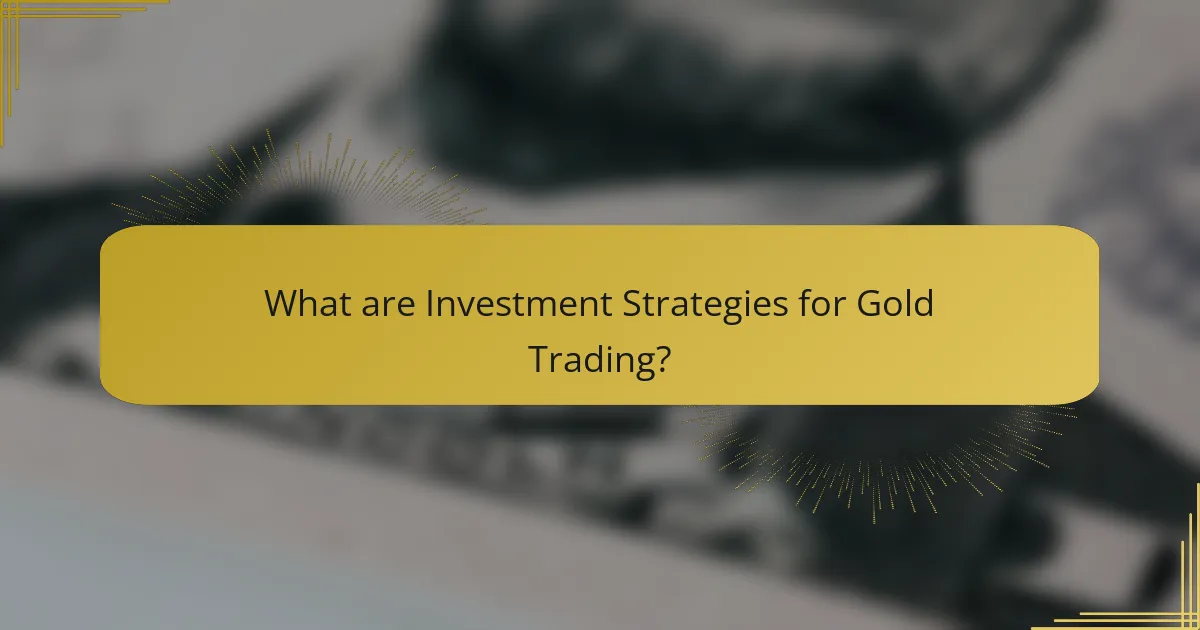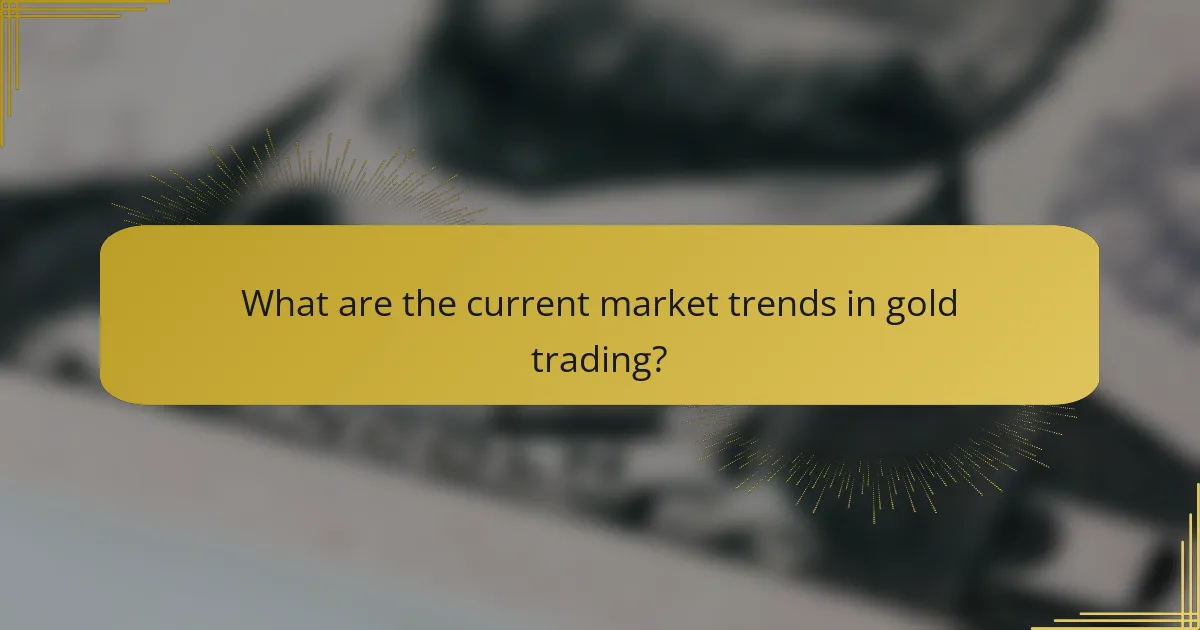Investment strategies for gold trading encompass various approaches aimed at maximizing returns while effectively managing risks. Key strategies include long-term buying and holding of gold, trading gold futures, and investing in gold exchange-traded funds (ETFs). These methods allow investors to leverage gold’s historical appreciation and act as a hedge against economic downturns. Additionally, effective risk management techniques, such as diversification and stop-loss orders, are essential for protecting investments in a volatile market. Current trends indicate a rising demand for gold driven by economic uncertainties, making it an increasingly attractive option for both individual and institutional investors.

What are Investment Strategies for Gold Trading?
Investment strategies for gold trading include various approaches to maximize returns while managing risks. One common strategy is to buy and hold gold as a long-term investment. This approach capitalizes on gold’s historical tendency to appreciate over time. Another strategy is trading gold futures, which allows investors to speculate on price movements without owning the physical asset.
Additionally, gold exchange-traded funds (ETFs) offer a way to invest in gold with lower costs and greater liquidity. Investors may also use technical analysis to identify trends and make informed trading decisions based on price patterns.
Diversification is another key strategy, where gold is included in a broader portfolio to reduce overall risk. According to historical data, gold often performs well during economic downturns, making it a valuable hedge against market volatility.
These strategies can be tailored to individual risk tolerance and investment goals, providing flexibility in trading gold.
How do these strategies vary across different market conditions?
Investment strategies for gold trading vary significantly across different market conditions. In a bullish market, investors may adopt aggressive strategies, focusing on long positions to maximize profits. Conversely, in a bearish market, strategies often shift towards hedging or short selling to mitigate losses. During periods of high volatility, traders might implement risk management techniques such as stop-loss orders to protect capital. In contrast, in stable markets, investors may prefer longer-term holding strategies, capitalizing on gradual price increases. Historical data shows that gold prices often rise during economic uncertainty, prompting investors to seek safe-haven strategies. Thus, the effectiveness of specific strategies is heavily influenced by prevailing market dynamics.
What factors influence the effectiveness of gold trading strategies?
The effectiveness of gold trading strategies is influenced by market trends, economic indicators, and geopolitical events. Market trends dictate the supply and demand dynamics for gold. Economic indicators, such as inflation rates and interest rates, affect investor sentiment towards gold. Geopolitical events, such as conflicts or trade tensions, can lead to increased demand for gold as a safe-haven asset. Additionally, technical analysis and historical price patterns play a crucial role in formulating successful strategies. For instance, during economic uncertainty, gold prices typically rise, reinforcing the strategy of investing in gold during such periods.
How do economic indicators impact gold trading strategies?
Economic indicators significantly impact gold trading strategies. Economic indicators, such as inflation rates and employment data, influence investor sentiment. When inflation rises, gold often becomes a safe-haven asset. Conversely, strong employment figures may lead to lower gold prices as investors favor riskier assets. Interest rates also play a crucial role. Higher interest rates typically decrease gold’s appeal since the opportunity cost of holding gold increases. Additionally, geopolitical events reflected in economic indicators can lead to increased volatility in gold prices. Historical data shows that during economic downturns, gold prices tend to rise as investors seek stability. Thus, traders adjust their strategies based on these indicators to optimize their positions in the gold market.
Why is gold considered a valuable investment asset?
Gold is considered a valuable investment asset due to its historical stability and intrinsic value. It serves as a hedge against inflation and currency fluctuations. Gold has maintained its purchasing power over long periods. For example, during economic downturns, gold prices often rise as investors seek safe-haven assets. According to the World Gold Council, gold has outperformed other asset classes over the last two decades. Its finite supply adds to its value, as mining new gold becomes increasingly difficult. Additionally, gold is universally recognized and accepted, making it a liquid asset. This combination of factors solidifies gold’s status as a reliable investment.
What historical trends support gold’s investment potential?
Gold has historically demonstrated strong investment potential through various economic cycles. During periods of inflation, gold prices typically rise as it serves as a hedge against currency devaluation. For instance, between 1971 and 1980, inflation rates surged, and gold prices increased from $35 to over $800 per ounce.
Additionally, gold often appreciates during economic downturns. In the 2008 financial crisis, gold reached an all-time high as investors sought safety. From 2007 to 2011, gold prices rose from around $600 to over $1,900 per ounce.
Global geopolitical tensions also drive gold’s value. Historical events, such as the Gulf War in the early 1990s, saw significant increases in gold prices due to market uncertainty.
Furthermore, the long-term trend shows that gold has outperformed many asset classes over the past few decades. For example, from 2000 to 2020, gold prices increased by approximately 500%, while the S&P 500 index saw a gain of around 200%.
These trends illustrate that gold remains a reliable investment, particularly in times of economic instability and inflation.
How does gold compare to other investment assets?
Gold is often considered a safe-haven asset compared to other investment assets. It tends to retain value during economic downturns. For instance, during the 2008 financial crisis, gold prices increased by over 25%. In contrast, stock markets experienced significant declines. Gold also serves as a hedge against inflation, while other assets may lose purchasing power. Historically, gold has outperformed many traditional investments during periods of high inflation. Additionally, gold has low correlation with equities, providing diversification benefits in a portfolio. This characteristic can reduce overall investment risk. Therefore, gold plays a unique role in investment strategies, especially in uncertain economic climates.

What are the current market trends in gold trading?
Current market trends in gold trading indicate a rising demand driven by economic uncertainties. Investors are increasingly viewing gold as a safe-haven asset amid inflation and geopolitical tensions. In 2023, gold prices have fluctuated, reaching over $2,000 per ounce at times. Central banks worldwide have been accumulating gold reserves, further supporting its value. Additionally, the shift towards digital gold, such as cryptocurrencies backed by gold, is gaining traction. The global market is witnessing increased retail participation in gold trading through online platforms. These trends suggest a robust interest in gold as a long-term investment strategy.
How can investors identify emerging trends in the gold market?
Investors can identify emerging trends in the gold market by analyzing market data and economic indicators. They should monitor gold prices, trading volumes, and historical trends. Technical analysis tools, such as moving averages and trend lines, can help predict future movements. Economic factors, including inflation rates and currency strength, also influence gold prices. News related to geopolitical events and central bank policies can signal shifts in demand. Reports from industry experts and market analysts provide insights into potential trends. Additionally, tracking investments in gold-related ETFs can indicate market sentiment. Keeping a close watch on supply chain dynamics, such as mining production and reserves, is essential for understanding market changes.
What tools and resources are available for trend analysis?
Trend analysis tools and resources include software, websites, and data services. Popular software options are MetaTrader and TradingView. These platforms offer charting capabilities and technical indicators. Websites like Yahoo Finance and Google Finance provide market news and historical data. Data services such as Bloomberg and Reuters deliver real-time market analysis. Additionally, economic calendars help traders track important financial events. Research reports from financial institutions also offer insights into market trends. These tools and resources support informed decision-making in gold trading.
How do geopolitical events affect gold market trends?
Geopolitical events significantly influence gold market trends. They often lead to increased uncertainty, prompting investors to seek safe-haven assets like gold. Historical instances show that during conflicts or political instability, gold prices tend to rise. For example, in 2008, the financial crisis led to a surge in gold prices as investors fled to safety. Similarly, tensions in the Middle East have historically correlated with spikes in gold demand. Additionally, geopolitical events can disrupt supply chains, further driving up prices. Overall, the relationship between geopolitical events and gold market trends is well-documented and significant.
What role does supply and demand play in gold pricing?
Supply and demand significantly influence gold pricing. When demand for gold increases, prices typically rise due to scarcity. Conversely, if supply exceeds demand, prices tend to fall. For instance, in 2020, gold prices surged amid global uncertainty, reflecting heightened demand for safe-haven assets. Additionally, gold mining production impacts supply levels. In 2021, global gold mine production was approximately 3,000 metric tons, affecting market availability. Thus, fluctuations in supply and demand directly correlate with gold’s market value.
How do mining outputs influence gold supply?
Mining outputs directly influence gold supply by determining the amount of gold available in the market. Increased mining outputs lead to a higher supply of gold. This higher supply can stabilize or lower gold prices due to increased availability. Conversely, reduced mining outputs can create scarcity, potentially driving prices up. For instance, global gold production was approximately 3,000 metric tons in 2022. If production decreases significantly, the limited supply can heighten demand and elevate prices. Thus, mining outputs are a critical factor in gold supply dynamics.
What impact do global economic conditions have on gold demand?
Global economic conditions significantly influence gold demand. During economic uncertainty, investors often seek gold as a safe-haven asset. For example, in 2008, gold prices surged as the financial crisis unfolded. Inflation also drives demand; when inflation rises, gold is viewed as a hedge. In 2020, gold prices increased due to pandemic-related economic fears. Additionally, currency fluctuations impact gold demand. A weaker dollar typically boosts gold prices, as seen in the recent years when the dollar declined. Overall, gold demand is closely tied to the health of the global economy, reflecting investor sentiment and market stability.

What are effective risk management techniques for gold trading?
Effective risk management techniques for gold trading include diversification, stop-loss orders, and position sizing. Diversification reduces risk by spreading investments across different assets. For example, investing in gold stocks, ETFs, and physical gold can mitigate potential losses. Stop-loss orders automatically sell a position at a predetermined price. This limits losses in volatile markets. Position sizing involves determining the amount of capital to risk on each trade. A common guideline is to risk no more than 1-2% of total capital on a single trade. These techniques help traders manage exposure and protect their investments in fluctuating gold markets.
How can investors mitigate risks associated with gold trading?
Investors can mitigate risks associated with gold trading by diversifying their portfolios. Diversification reduces the impact of a poor-performing asset on the overall portfolio. Investors should consider including different asset classes alongside gold, such as stocks, bonds, or real estate. This strategy helps balance the risks and potential returns.
Additionally, using stop-loss orders can protect against significant losses. A stop-loss order automatically sells gold when it reaches a predetermined price. This limits the downside risk in volatile markets.
Investors should also stay informed about market trends and economic indicators. Understanding factors like inflation rates and geopolitical events can influence gold prices.
Finally, investing in gold through exchange-traded funds (ETFs) can provide liquidity and lower transaction costs. ETFs allow investors to gain exposure to gold without holding physical bullion. This method can reduce risks associated with storage and security.
What strategies help in setting stop-loss orders?
To set effective stop-loss orders, traders can employ several strategies. One common strategy is the percentage-based stop-loss, where a trader sets a stop-loss order at a specific percentage below the entry price. For example, a 5% stop-loss means the order will trigger if the asset declines by 5%. Another strategy is the support and resistance levels approach. Traders identify key support levels and place stop-loss orders just below these levels to minimize potential losses.
Using volatility-based stop-losses is also effective. This method involves setting stop-loss orders based on the asset’s historical volatility. Traders can use tools like the Average True Range (ATR) to determine appropriate stop-loss distances. Additionally, trailing stop-loss orders allow traders to lock in profits while minimizing losses. These orders adjust automatically as the asset price moves in a favorable direction.
Implementing these strategies helps manage risk effectively in gold trading. Traders can protect their investments while allowing for potential price fluctuations.
How do diversification and asset allocation reduce risk?
Diversification and asset allocation reduce risk by spreading investments across various assets and categories. This strategy minimizes the impact of poor performance in any single investment. When one asset class declines, others may remain stable or increase in value. For example, stocks and bonds often react differently to market conditions. Historical data shows that a diversified portfolio can lower volatility and enhance returns. According to a study by Vanguard, a well-diversified portfolio can reduce risk by up to 30%. This approach allows investors to achieve a more stable return over time.
What are the psychological aspects of risk management in trading?
The psychological aspects of risk management in trading include emotional control, decision-making, and risk perception. Traders often face fear and greed, which can distort their judgment. Emotional control helps traders stick to their strategies despite market fluctuations. Decision-making is influenced by cognitive biases, such as overconfidence or loss aversion. Risk perception varies among traders, impacting their willingness to take risks. Studies show that psychological factors can lead to irrational trading behaviors. For instance, a 2017 study by Shapira and Venezia found that traders with high emotional intelligence performed better in risk management. Understanding these psychological elements is crucial for effective trading strategies.
How can emotional discipline improve trading outcomes?
Emotional discipline can significantly improve trading outcomes by helping traders make rational decisions. It reduces impulsive actions driven by fear or greed. Traders with emotional discipline stick to their trading plans. They avoid overreacting to market fluctuations. This consistency leads to better risk management. According to a study by the CFA Institute, disciplined traders experience higher success rates. They are more likely to follow their strategies and achieve long-term profitability. Emotional discipline fosters patience, allowing traders to wait for optimal entry and exit points. Overall, it enhances decision-making and minimizes losses.
What common psychological pitfalls should traders avoid?
Traders should avoid common psychological pitfalls such as overconfidence, loss aversion, and emotional trading. Overconfidence can lead to excessive risk-taking. Studies show that overconfident traders often underestimate risks and make poor decisions. Loss aversion causes traders to hold onto losing positions too long. Research indicates that individuals feel losses more intensely than gains, leading to irrational choices. Emotional trading can result in impulsive actions based on fear or greed. Data suggests that traders who rely on emotions are more likely to experience significant losses. By recognizing and mitigating these psychological traps, traders can improve their decision-making processes.

What is the profit potential of gold trading?
Gold trading has significant profit potential due to its historical value and market demand. The price of gold can fluctuate widely based on economic conditions, geopolitical events, and currency strength. For instance, during economic uncertainty, gold often acts as a safe-haven asset, driving its price up. In 2020, gold prices surged to a record high of over $2,000 per ounce amid the COVID-19 pandemic.
Traders can capitalize on these price movements through various strategies, such as day trading or long-term investing. Additionally, leveraging options and futures contracts can amplify potential returns. However, it is essential to note that while the profit potential is substantial, risks are also involved, including market volatility and changes in investor sentiment.
The profit potential of gold trading is further supported by historical trends, as gold has consistently appreciated over time, making it an attractive investment for wealth preservation.
How can investors maximize returns from gold trading?
Investors can maximize returns from gold trading by employing strategic buying and selling techniques. Timing the market is crucial; investors should buy during price dips and sell during peaks. Utilizing technical analysis helps identify trends and price patterns. Diversifying gold investments across different forms, such as ETFs, futures, and physical gold, can mitigate risks. Keeping abreast of global economic indicators and geopolitical events informs better trading decisions. Historical data shows that gold often performs well during economic uncertainty, making it a valuable asset. Additionally, leveraging tools like stop-loss orders can protect profits and minimize losses.
What strategies are effective for short-term versus long-term trading?
Short-term trading strategies include day trading and swing trading. Day trading involves buying and selling within the same trading day. Swing trading captures price swings over several days or weeks. Both strategies rely on technical analysis and market trends.
Long-term trading strategies include buy-and-hold and value investing. Buy-and-hold involves purchasing assets and holding them for years. Value investing focuses on finding undervalued assets with strong fundamentals. These strategies typically rely on fundamental analysis and long-term market trends.
Short-term strategies often involve higher risks due to market volatility. Long-term strategies generally aim for steady growth, reducing the impact of short-term market fluctuations. Historical data shows that long-term investments often yield higher returns over time compared to short-term trading.
How does leverage impact potential profits in gold trading?
Leverage significantly amplifies potential profits in gold trading. It allows traders to control larger positions with a smaller amount of capital. For example, a leverage ratio of 10:1 means that a trader can control $10,000 worth of gold with just $1,000. If gold prices increase by 5%, the profit on the $10,000 position would be $500. However, the trader only invested $1,000, resulting in a 50% return on investment. Conversely, leverage also increases the risk of losses. A 5% decrease in gold prices would lead to a $500 loss, wiping out the initial investment. Thus, while leverage can enhance profits, it equally heightens the risk of significant losses.
What are the costs associated with trading gold?
The costs associated with trading gold include transaction fees, storage fees, and market spreads. Transaction fees are charged by brokers for executing trades. These fees can vary based on the trading platform used. Storage fees apply when holding physical gold in secure facilities. These fees are typically charged monthly or annually. Market spreads represent the difference between the buying and selling price of gold. This spread can fluctuate based on market conditions. Additionally, taxes may apply depending on the jurisdiction and the type of gold traded. Understanding these costs is crucial for effective gold trading strategies.
How do transaction fees affect overall profitability?
Transaction fees directly reduce overall profitability in trading. Higher transaction fees lead to lower net returns from trades. For instance, if a trader makes a profit of 5% on a gold investment but incurs a 2% transaction fee, the effective profit drops to 3%. Frequent trading increases cumulative fees, further eroding profits. According to a study by the CFA Institute, transaction costs can account for up to 20% of total trading costs over time. Therefore, minimizing transaction fees is crucial for maximizing profitability in gold trading.
What considerations should be made regarding storage and insurance?
Considerations for storage and insurance of gold investments include security, accessibility, and valuation. Secure storage options include bank safety deposit boxes or professional vault services. Insurance should cover the full value of the gold, including theft and damage. It is essential to assess the insurance policy’s terms, including deductibles and coverage limits. Regularly updating the inventory and valuation ensures accurate insurance coverage. Additionally, consider the location of storage to minimize risks from natural disasters or political instability.
What best practices should investors follow for successful gold trading?
Investors should follow several best practices for successful gold trading. First, they must conduct thorough market research. Understanding market trends helps in making informed decisions. Second, investors should diversify their portfolios. This reduces risk associated with price volatility in gold. Third, they must set clear investment goals. Defining objectives guides trading strategies and risk tolerance.
Fourth, investors should stay updated on economic indicators. Factors like inflation and interest rates significantly affect gold prices. Fifth, using stop-loss orders is crucial. This strategy helps minimize potential losses during market downturns. Finally, investors should consider long-term holding strategies. Historically, gold has proven to be a reliable store of value over time.
Investment Strategies for Gold Trading encompass various approaches aimed at maximizing returns while managing risks associated with gold investments. Key strategies include buying and holding gold, trading gold futures, and utilizing gold exchange-traded funds (ETFs) for liquidity and lower costs. The effectiveness of these strategies is influenced by market conditions, economic indicators, and geopolitical events, with historical trends supporting gold’s role as a valuable investment asset. Additionally, effective risk management techniques, such as diversification and stop-loss orders, are crucial for protecting investments and optimizing profit potential in gold trading.